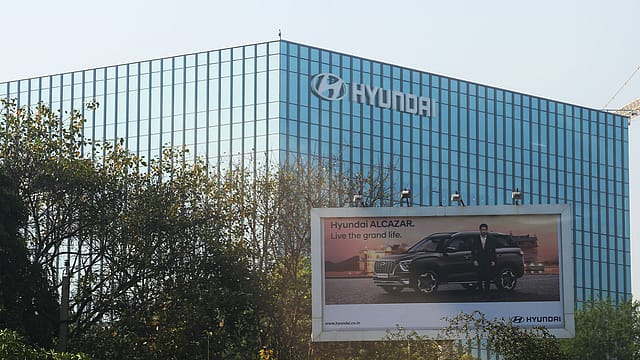Why Hyundai Motor going public tells you a different story
ADVERTISEMENT

If Nvidia founder Jensen Huang signing across the chest of a girl signals the peak around AI, a similar parallel can be drawn with Korean chaebol, Hyundai Motor, going public with India's largest-ever public issue worth ₹27,870 crore (over $3 billion) by offloading 17.5% stake. At the higher end of the band of ₹1,960, the company is valued at over $19 billion, significantly lower than half the $47 billion market cap enjoyed by Maruti, which went public in 2003.
What’s pertinent is that Hyundai is not tapping the market to raise funds for its Indian arm. Instead, the parent is making money off India's retail and institutional investors by offering 142.2 million shares, or 17.5% stake, as an offer-for-sale (OFS).
It’s noteworthy that the parent, ahead of the listing, transferred significant funds from the company via a special dividend. As of March 2023, Hyundai held cash and cash equivalents of ₹17,741 crore, but in March 2024, a special dividend of ₹13,270 per equity share was paid to Hyundai Motor Company (HMC), its promoter, amounting to ₹10,782 crore. This payout led to a reduction in the cash to ₹9,017.34 crore. Interestingly, the dividend comes at a time when Hyundai is exploring an electric vehicle (EV) strategy in India—a venture that will demand substantial financial investment. The timing of the dividend and the cash reduction could potentially strain Hyundai India's financial flexibility, particularly as it enters this capital-intensive phase in the EV market.
Hyundai's strategic move ensures that the parent reaps substantial rewards from an effervescent Indian market, contrasting sharply with the decades it took to build its profit base. Hyundai's cumulative profit of ₹28,161 crore over 24 years has been matched in a matter of days through the IPO.
December 2025
The annual Fortune 500 India list, the definitive compendium of corporate performance, is out. This year, the cumulative revenue of the Fortune 500 India companies has breached $2 trillion for the first time. Plus, find out which are the Best B-schools in India.
The Korean major’s journey in India has been marked by a perpetual race to catch up with Maruti Suzuki, the Japanese automaker that entered the market in 1983 and has since dominated. Hyundai, which began its Indian operations in 1996 with the launch of the Santro in 1998, now holds a market share of 14.22% as of FY24, a distant second to Maruti Suzuki's commanding 42%.
As of FY24, Maruti Suzuki lords over the passenger vehicle market with sales of ₹1.35 lakh crore and profit of ₹13,209 crore, in comparison Hyundai is less than half of Maruti with sales of ₹69,829 crore and profits of ₹6,060 crore. Though from a CAGR perspective, Hyundai sales look impressive over a 24-year period compounding at 19.8% compared with 13.7% for Maruti. In terms of profit, both are neck and neck with Hyundai's profit compounding at 24.1% vs 19.9% for Maruti.
The listing move comes amid hyper competition and electrification trend sweeping across the passenger vehicle segment with domestic and foreign players upping the ante. In fact, Hyundai's sibling, Kia Motors, has demonstrated a far-more impressive performance than Hyundai. For instance, since its entry in 2019, Kia Motors has raced away to a revenue of ₹39,042 crore and profit of ₹2,122 crore in FY23 even as it cornered 5.71% market share (FY24). To put into context, Kia's sales are 56% of Hyundai's revenue, while profits account for over 35%, more than a third.
In just five years, Kia's revenue compounded at the rate of 194.5% versus 7.9% for Hyundai. Also, the rip-roaring performance saw the sibling swinging from a loss of ₹199 crore in FY19 into the black with ₹2,122 profit versus ₹4,709 crore for Hyundai.
Though Kia and Hyundai Motor operate independently, Hyundai is the parent since Kia was acquired in 1998 after it filed for bankruptcy in 1997. In effect, even as the elder sibling hits its maturity curve, the parent will back its younger sibling to make the most of India’s growth story.
The listing not only underscores the chaebol's financial acumen but also sets a precedent for other global companies eyeing India's vibrant “investment arbitrage”. The fact that MNCs such as Whirlpool offloaded in the public market a part of its holding in the India listed entity, and now that Novartis and ITD Cementation are looking to exit their businesses at a peak just shows that there is more money to be made off the market than investing in the business.
While the multiple of 26.28x, based on FY24 earnings, may seem reasonable, Hyundai’s decision to go public signals that the Korean major may no longer see the Indian automotive market as offering the same high-growth potential it once did—especially when compared to its kin, Kia. It’s no surprise, then, that the parent company chose to seize this moment, leaving Indian investors to savour the unfolding K-drama.
